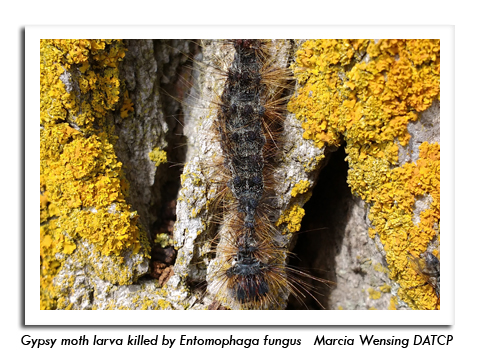
 |
|
|
Nursery & Forest
Volume 62 Number 14 Date 08/03/2017 FOLIAR NEMATODE - Numerous catmint (Nepeta sp.) plants at a nursery in Vilas County were showing symptoms indicative of feeding by foliar nematodes. These microscopic worm-like organisms live on and within the leaf tissue of hundreds of herbaceous and woody ornamental plant species, as well as vegetables. Nematode infestation can cause stunting or twisting of foliage in young plants, and often produces angular, necrotic leaf streaks bordered by leaf veins in mature plants. The symptoms become more pronounced and recognizable later in the growing season. This pest is readily spread among plants by splashing water, such as from rainfall or overhead irrigation. Reducing leaf wetness is advised to prevent the nematodes from spreading. Replanting susceptible stock in areas recently infested with nematodes should be avoided since the nematodes can temporarily survive in soil. Cuttings from infected stock for should never be used for propagation, and decontamination of tools following contact with plants suspected of being infected is good practice. Chemical control is not effective against this pest. DOWNY MILDEW - This common fungal problem was confirmed on 'Valiant' grapes from Iron County earlier this week. Downy mildew is characterized by whitish mold that develops on the grape leaf undersides, stems, and on fruits. Upper leaf surfaces may show yellowing opposite the moldy leaf undersides. Mildew occurrence can be minimized by reducing humidity and improving air circulation. The fungus overwinters as spores on old leaves or as mycelium in bud tissue, so thorough end-of-season sanitation is important where mildew infection has been severe in 2017. TAR SPOT - This late-season leaf blight disease is developing on maple trees across Wisconsin. The pale yellow lesions now apparent will soon become raised, black, tar-like lesions. Tar spot is an aesthetic disorder best controlled by clearing and disposing of infected leaves in fall to prevent the spores from spreading. In rare cases where treatment is warranted, three fungicide applications are necessary for control: one at bud break, one when leaves are half expanded, and one when leaves are fully expanded. OAK TWIG PRUNER - Damage attributed to this longhorned beetle was observed last week in Dunn County. Boring by the larval stages in small branches and twigs can result in considerable branch-drop by late summer. If lawns are covered with twigs and branches 20-40 inches long with the leaves still attached, the oak twig pruner is likely the cause. Property owners should look for a small plug of wood or frass at the end of the twig to confirm. Hardwood trees attacked by this beetle may be seriously damaged but are usually not killed. The most effective control is to collect and burn the fallen branches in autumn or winter. -- Timothy Allen, DATCP Nursery Inspector GYPSY MOTH - Oak trees severely infested with this defoliating pest were observed by inspectors last week in Washington County. Both male and female moths, caterpillars, and pupae were found. A few of the gypsy moth caterpillars were suspended from the bark of trees in an inverted 'V,' and were presumed to have succumbed to gypsy moth nuclear polyhedrosis virus (NPV), a virus that kills caterpillars and can reduce gypsy moth populations in Wisconsin in some years. Gypsy moth larvae are also susceptible to the fungus, Entomophaga maimaiga, which can be recognized by dead caterpillars that hang straight down from the tree bark. -- Marcia Wensing, DATCP Nursery Inspector 




|
|
|